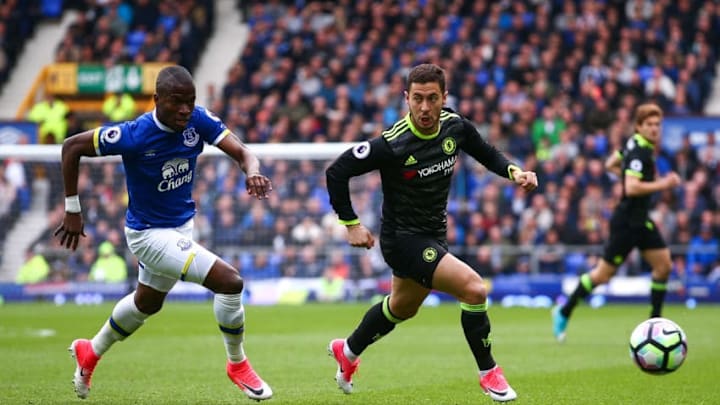Everton set up a series of one-on-one battles to neutralize Chelsea’s strengths. They succeeded in keeping Eden Hazard and the midfield in check, while Chelsea relied on their depth to create offence.
Idrissa Gueye played the role of Ander Herrera for Everton on Sunday. Gueye shadowed Eden Hazard, never letting the Chelsea man find space, make a run onto a pass or recover loose balls. Gueye limited Hazard to three shots – none on target. In keeping with the old adage, Gueye would let either the ball or the man past him, but never both.
In midfield, Ross Barkley and Tom Davies kept close tabs on Nemanja Matic and N’Golo Kante. The Everton duo did not keep Chelsea’s midfield pair in their pocket as Gueye did with Hazard. But the Everton pair prevented Matic and Kante from their usual rhythm of squeezing the ball loose and picking up the scraps.
Must Read: Tactics and transfers: An open letter to Cesc Fabregas and Gary Cahill
Matic and Kante are most effective when they stay relatively close together. One will close down the ball carrier while the other positions himself to recover the ball off a tackle or interception. Barkley and Davies positioned themselves to reach those loose balls before either of the Blues. They interrupted Kante’s and Matic’s control of space and flow in the midfield. This in turn limited their ability to pivot play into a counter-attack.
Chelsea’s depth across the pitch offered them options to overcome these tactics. Antonio Conte has more than one player who can create a moment of brilliance in high-pressure situations, as Pedro demonstrated. The Blues also have enough positional nous that the wingbacks and wingers – primarily Pedro, again – can join in the midfield to relieve pressure on Matic and Kante.
Even so, Chelsea need to adapt their tactics to overcome man-marking. As Manchester United and now Everton have shown, man-marking can take Hazard out of the game. Chelsea’s lack of productive striker means the opposition can dedicate more attention to Hazard. By doing so, they remove a vast portion of Chelsea’s offensive threat.
David Luiz : "Il est où Hazard ?"
— Everton FC France (@EFCFrance) May 1, 2017
Idrissa Gueye "Il est dans ma poche !"
Magnifique @IGanaGueye ! 😂😂https://t.co/ZgK6q2A7bo#EVECHE
Chelsea’s top-line need is a potent striker, who will alleviate the pressure on Eden Hazard. An opponent can get away with man-marking one forward. Few would venture to man-mark two. A more mobile striker will provide a ready outlet to Eden Hazard when he has the ball. Gueye, like Herrera, would tactically foul Hazard as necessary. Hazard needs a teammate nearby to receive the quick pass, either to set up a one-two or simply to keep the play alive.
A similar level of fluidity in midfield would also minimize the effect of man-marking N’Golo Kante and Nemanja Matic. If the wingers and wing-backs can constrict the opposition ball carriers in midfield, they can create and recover more loose balls.
Antonio Conte’s anticipated shift to a 3-5-2 formation will address many of these issues, provided he has the appropriate players. The additional midfielder can play forward enough to play off of Eden Hazard, while also cleaning up the area around N’Golo Kante and his partner next season. This advances the case for Chelsea to acquire Timeouye Bakayoko or – in the best, barely possible scenario – Marco Verratti.
Next: Chelsea's recent wins are major steps towards Premier League title
Everton’s man-marking sufficiently neutralized Chelsea’s main offensive threat, and blunted the Blues’ usual midfield dominance. Chelsea can make do against these tactics, but they need long-term tactical and personnel solutions. As with many other aspects, the situation is tolerable now but will be a significant vulnerability next year.
